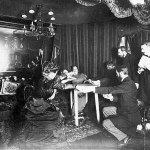A house of God turned into the sinful playground of the rich and powerful nuns, the former Dominican Cloister, Kleines Klingental in Basel is said to be haunted by the ghostly nuns, still to this day praying to be released from their sins.
In the cityscape of Basel, few would suspect that beneath its serene facades and picturesque medieval streets, lurk tales of scandal, sin, and spectral unrest. One of the city’s most persistent and unsettling legends clings to the site of Kleines Klingental, a former nunnery turned barracks, museum, and, by some accounts, one of Basel’s most active haunted sites.
Read more: Check out all ghost stories from Switzerland
Today it goes under the name of The Kleines Klingental Museum and showcases statues from the Cathedral. It is here, in what was once a house of prayer and seclusion, that shadows from centuries past still move in the dark corners. And if the legends are to be believed, the ghosts that roam these halls were once no ordinary nuns.


A Cloister of Contradictions
Founded in the 13th century, the Klingental Monastery was established in Kleinbasel, just across the Rhine from Basel’s bustling old town. It dates back to at least 1274 when twelve Dominican nuns settled in Kleinbasel, having come to Basel from Alsace via the Black Forest.
Officially a place of pious retreat for noblewomen, it soon became something altogether different. The Klingental Monastery, which at its peak was home to 52 nuns, was the richest and most distinguished monastery in Basel. The women who sought sanctuary here were largely from wealthy, aristocratic families, bringing with them not only their dowries and fine possessions but also their personal attendants and, as rumor has it, a disdain for the strictures of monastic life.


Among the nuns spending time in the cloister were two representatives of the Eptingen family, the cousins Sophie and Elisabeth, appear. Susanna, a daughter of Georg von Hattstatt and Elisabeth von Tierstein, is also documented as a nun in 1334. Clara, the daughter of the Basel mayor Henmann II von Ramstein, was also a nun at St. Clara.
There were cases of women being sent to the convent against their will, like Anna von Ramstein. She was the cousin of Susanna von Ramstein, whose father was mayor of Basel in the 15th century. She was said to have been rebellious at the Steinen monastery and, after a failed escape attempt, was brought to St. Clara that she successfully escaped from in 1462.


The nun Katharina, mentioned in 1357, was the stepdaughter of Claus Berner the Younger and the records curiously says she was “taken from the Jews.” In a pogrom before the plague in 1349, the Jewish inhabitants of Basel were expelled from the city or killed. Many of their children were forcibly taken from their families to convert them to the Christian faith, and this nun was most likely one of them.
The four nuns Agnes, Ennelin, Gredlin, and Katharina von Hachberg were of roya blood being the daughters of Margrave Rudolf III of Hachberg-Sausenberg (1343-1428) and Röteln and his wife Anna von Neuenburg (1374-1427).
So how then, did this seemingly pious and respected community of women get the reputation of evil and sinful nuns?


From Sacred to Profane at Kleines Klingental
By the late Middle Ages, the Dominican cloister’s reputation was in tatters. Cloistered walls became veils for intrigue. Lovers came and went under the cover of night, and luxuries forbidden by monastic vows flowed freely behind thick stone walls. Chroniclers of the era spoke darkly of secret births and whispered of infants drowned in the cold, rushing waters of the Rhine to preserve the illusion of chastity.
Attempts by church authorities to restore order and penitence to the monastery met with clever defiance and the noble-born nuns using their rank and influence to evade the scrutiny of even the most zealous inquisitors.
Now, how true were these rumors? Did they really do all of the things their legend accuse them of? Or is this just yet another example of the male dominated church looking down on the female community, perhaps the most powerful women could be at that time? Or was it when the male dominated military moved in that the ghostly legends started?


The Military Takes Over
With the arrival of the Reformation in the 16th century, the monastery was secularized, and much of its land was repurposed. By the 19th century, the site had become a barracks. But the soldiers stationed at Kleines Klingental soon discovered they shared their quarters with more than just their fellow men.
Nights in the old nunnery became restless affairs. Strange wailing echoed through the empty corridors. Disembodied footsteps padded softly across stone floors. Soldiers reported encountering ghostly figures clad in flowing black habits, faces hidden in shadow, clutching rosaries or silently weeping. It was whispered that these were the unquiet souls of the sinful nuns, cursed to wander the halls where they had once schemed, sinned, and sought fleeting pleasures.


Some claimed that the phantoms prayed aloud at midnight, their voices mournful, seeking forgiveness too long denied. Others spoke of ghostly processions in the dead of night — pale women gliding past candlelit walls, vanishing into darkness. Apparitions of a mother cradling a child before disappearing into the old well, rumored to have once been used to dispose of unwanted infants, chilled even the most hardened soldier’s blood.
Even the soldiers quartered there left a deadly imprint on the barracks. As they were renovating the place, 29 skeletons of the soldiers, most likely dying in an outbreak of the Spanish flu and buried on the grounds, were found.
The Ghostly Legacy Lives On in Kleines Klingental Museum
The soldiers left in 1966. Today, the Kleines Klingental Museum occupies part of the historic site. While much of the monastery was lost to time and urban development, several original monastic cells and the old cloister remain intact. And with them, so too, it seems, do the phantoms.
Artists in the art studios in the right wing of the barracks and caretakers who have spent long evenings within the ancient walls speak of unexplained chills, flickering lights, and strange nocturnal sounds. Some report seeing figures in habits lingering in shadowed doorways or passing by in mirrors, only to vanish when pursued. The local legend insists that the unrepentant souls of Kleines Klingental still walk, their sins too great to allow them peace centuries after their death.
Newest Posts
-

The Restless Spirits of Kleines Klingental: Basel’s Haunted Nunnery
A house of God turned into the sinful playground of the rich and powerful nuns, the former Dominican Cloister, Kleines Klingental in Basel is said to be haunted by the ghostly nuns, still to this day praying to be released from their sins.
-

Anchanchu: The Shapeshifting Vampire of Bolivia’s Lonely Roads
In the loneliest corner of the Andean highlands of Bolivia and Peru, an Aymaran legend of the Anchanchu or the Abchanchu is said to lurk. Disguised as an elderly man, weary from his travels, he uses people’s goodness to attack and drink their blood.
-

The Legend of the Jiāngshī: China’s Hopping Vampire
With stiff limbs after rigor mortis has set in, the Chinese vampire entity, the Jiāngshī is after the life force of the living. But where did the lore of the hopping undead really come from?
-

The Knocking Ghost of Utengasse 47: Basel’s Poltergeist Case
In a small apartment at Utengasse 47 in Basel, a poltergeist was said to torment the family living there. It got so bad and they found no solution that the family had to vacate the place instead.
-

Spiritism and the Religion of Spirit Communication
Spiritism or Kardecism is a philosophy and religion of spirit communication. After being inspired by the Spiritualist movement, the French Allan Kardec developed the loose movement of seances, mediums and communicating with the dead into something people still practice today.
-

Spiritualism and the Occult: Automatic Writing and When Ghosts Slide Into Your DMs
In the height of the spiritualism movement of séances, mediums and table turning, automatic writing was a popular way to communicate with the dead. But what type of writing and messages did the practice leave us with?
-

Table Turning: When Spirits Spill the Tea Through Furniture
One of the earliest ways of communicating with the dead in the modern era was through Table Turning or Table Tipping. For many it was nothing more than a fun parlor trick and game, but for others it became a lifestyle and the foundation of a new spiritual movement.
-

The Dark Origins of the Ouija Board: A Mysterious History of Spirit Communication
The Ouija Board has a long and winded history that has created its own lore and rules. What is really the truth behind the board, where spiritualism meets consumerism?
-

The Ouija Board Murder in Buffalo
Many horrible things have been blamed on the Ouija Board over the years. One of the most famous cases was the murder often named The Ouija Board Murder in Buffalo were a woman in Buffalo was killed after the Ouija Board pointed her out in a mission for revenge.
-

The Spiritualist Movement: The Fox Sisters Who Started a Ghostly Revolution as a Prank
It’s impossible talking about communicating with the dead without talking about The Fox Sisters and their impact they had on the Spiritualism movement as well the enduring popularity ghosts and the afterlife have on people, even when its well known fraudsters performing.
-

The Demon Zozo: The Mysterious and Terrifying Entity of the Ouija Board
A collective memory of people summoning an entity called Zozo has taken over the Ouija Board sessions. The demon who goes by many names is said to be conjured from the human mind, but there are still those claiming that the demon Zozo is something real to fear.
-

The Philip Experiment: The Spirit Created by Scientists
Spiritism September: After a long experiment, a made up spirit started to haunt a group’s seances. What really happened during the Philip experiment, and what does it tell us about what lengths humans go to believe in ghosts?
References:
Basler Phänomene: Spuk, Phantome, Poltergeister | barfi.ch
Happy Halloween! 🎃 Ein Streifzug durch Basels grusligste Orte — Bajour
Huhuuuh! – Sieben Spukhäuser in der Region | TagesWoche
Museum Kleines Klingental – Wikipedia
St.Clara und das Clarissenkloster in Basel




